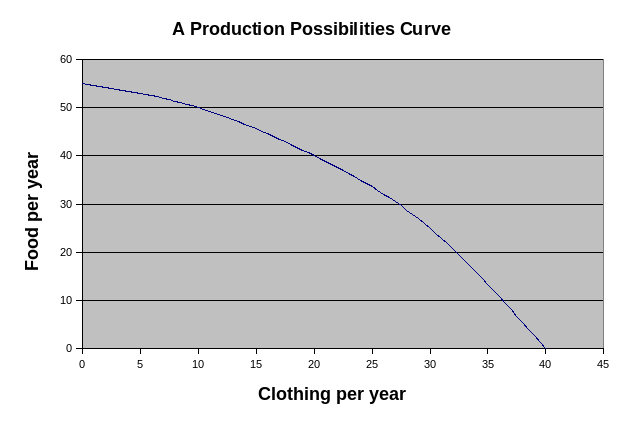
- •Lecture 3: production possibilities and opportunity cost
- •Resources, Technology, and Production Possibilities
- •2. Production Possibilities Curve
- •Table Annual Production Possibilities for Food and Clothing
- •3. Law of Increasing Opportunity Cost
- •Economic Growth: Expanding Production Possibilities
- •1. Increased quantities of economic resources.
- •2. Improved quality of economic resources.
- •3. Advances in technology.
- •Summary:
Table Annual Production Possibilities for Food and Clothing
Type of good |
Production possibilities (alternatives) |
||||
Food per year (tons) |
55,000 |
50,000 |
40,000 |
25,000 |
0 |
Clothing per year (number of garments) |
0 |
10,000 |
20,000 |
30,000 |
40,000 |

A basic reason that costs increase with successive units of output is the existence of specialized inputs that are more productive in a particular use. As we increase clothing production during the year, we have to sacrifice more and more food for each successive increment in the number of garments produced per year. You can see this by concentrating on the land that would have to be reallocated to build clothing factories and grow the fibers used to make cloth. At first the land least specialized for growing food can be reallocated to clothing production. As more fertile food land is transferred for successive increments in the annual production of clothing, the loss per acre transferred increases simply because the land more adapted to food production produces more food per acre than the less specialized land.
Similarly, at first the vehicles and equipment least specialized in the production of food, such as trucks and tractors, can be transferred at low opportunity cost to clothing production. However, as we produce more clothing, we must adapt more specialized agricultural machinery, such as combines, for use in clothing production.
Because this type of machinery is more productive in food than in clothing production, the opportunity cost of additional clothing increases in terms of food sacrificed. Likewise, as clothing output increases, at first the workers least specialized in agricultural production are transferred to clothing production. As more and more workers are required to produce additional clothing, the more skilled and, therefore, more productive workers must be transferred out of food production. This increases the amount of food we must sacrifice to produce extra units of clothing.
Generalization: At any point in time, an economy achieving full employment and productive efficiency must sacrifice some of one good to obtain more of another good. Scarce resources prohibit such an economy from having more of both goods.
3. Law of Increasing Opportunity Cost
Because resources are scarce relative to the virtually unlimited wants which they can be used to satisfy, people must choose alternatives.
The amount of other products which must be forgone of sacrificed to obtain 1 unit of a specific good is called the opportunity cost of that good.
The law of increasing opportunity cost states that the opportunity cost of each additional unit output of a good over a period increases as more of that good is produced.
This law is an implication of the assumption that some economic resources are more suited than others to the production of particular goods.
Because this implication has been widely supported by empirical evidence, it is called a “law”.
Productive efficiency is attained when the maximum possible output of any one good is produced given the output of other goods.
Attainment of productive efficiency means we can't reallocate economic resources to increase the output of any single good or service without decreasing the output of some other good or service. Points on a production possibilities curve represent efficient use of productive resources, because once on the curve it's impossible to increase the output of one good without reducing the output of the other.
One factor that contributes to productive efficiency is division of labor, which is the breakdown of a larger process into particular tasks performed by workers who specialize in those tasks. By specializing, workers become more proficient at their jobs. The division of labor lets factories use mass production techniques that allow workers to produce more.
By dividing tasks, a factory obtains much more output per worker than if each worker had to build each unit of an entire finished product alone. For example, suppose you had to build an automobile by yourself. You'd have to mold the steel; assemble the body, chassis, and motor; and do all interior assembly. You'd have to be an expert in welding, electrical wiring, painting, and upholstering. Even if you were skilled in all these operations, it might take you as long as a year to produce a finished car.
With a division of labor, the numerous tasks involved would be assigned to many workers, each specializing in one task. By dividing tasks, managers can use sophisticated machinery and equipment and produce many more cars than would be possible if each worker tried to do all the tasks. A division of labor exists in a broader sense throughout the economy. People with specialized skills function are physicians, police officers, architects, musicians, and farmers.
